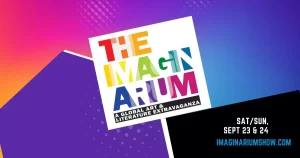
Discover a World of Art & Literature in Greenock!
Join us for an extraordinary cultural celebration at the brand new West End Gallery in Greenock! For two days only, immerse yourself in a captivating
Van Gogh’s painting of sunflowers is one of his most recognized works. The yellow flowers against a blue-green background stand out for their vibrant colours and simple style.
I saw a TV programme recently and using one of these x-ray machines the researchers were able to show that the Sunflowers were indeed vibrant. Over time, the colour intensity has been lost.
But, are these sunflowers just a pretty picture or do they hold deeper meaning? Throughout his short life, Van Gogh painted many subjects: from landscapes to portraits to still lifes. However, the common thread throughout all of his paintings is the message he wanted to share with the world. He had a troubled life that was filled with both joy and despair. In his letters and his paintings, you can see how this is expressed through the themes of loneliness, suffering, love, and faithfulness. With so much information available about this famous artist’s work, it can be challenging to figure out which details are important and where you can find them again if needed. Here is a look at Van Gogh’s Sunflowers: its history, symbolism, colours used, meaning and much more!
Van Gogh painted Sunflowers in Arles, in the south of France in 1888 and 1989. He painted a total of 5 large canvases with sunflowers in a vase.
During the year 1888, Van Gogh had two distinct periods of painting these large yellow flowers. The first period was between May and July when he worked on several smaller paintings of sunflowers. The second period was during August when he painted a larger work that would become known as the Sunflowers. The large painting of sunflowers was completed in August 1888. At this time, Van Gogh’s mental health was deteriorating. art experts say that this deterioration is shown in his later paintings as his brushstrokes became more frantic. I’m not sure how they know this for sure writing as an artist. Perhaps they compared the work Van Gogh did when they know his mood was brighter with paintings he did when he was feeling low.
Van Gogh used the sunflower as a symbol of brightness and optimism. The sunflower has grown in popularity over the last 100 years as people have learned more about Sunflowers and what they represent. Van Gogh used the sunflower as a central theme throughout his work to express his feelings of love and longing. He used the yellow sunflower as a simple image of optimism and the bright future ahead. The bright yellow colour of the sunflower is the exact opposite of the dark blue-green background behind the flowers; it represents optimism, warmth and life.
In a letter dated July 3, 1888, only a few months before his death, Van Gogh writes about the sunflower as a symbol of faithfulness and remembrance. He writes, “The sunflower will be a symbol for the painting, a thing that will make the people think of the South.”
In another of his letters Van Gogh wrote that the sunflowers communicated “gratitude”. If you’d like to read some of these letters you can athttps://vangoghletters.org/vg/letters.html.
The painting is considered a still life: a type of artwork that features objects that are not portraits of people or animals. The sunflowers are the main focus of the painting, but there are a few other elements that help tell the story. Nine sunflowers are arranged in a vase on the left-hand side of the painting. Five orange discs are on the right-hand side, along with a few sprigs of green grass. The arrangement of the flowers in a vase is significant. It indicates that the sunflowers are not growing in the wild. Instead, they are being cultivated. This could represent how Van Gogh was trying to cultivate happiness in his own life.
The bright yellow colour of the sunflowers may seem like it was chosen randomly, but it is a powerful message. The sunflower naturally blooms towards the sun, so when you look at the painting, you can see that the sunflowers are facing the sun with their heads tilted upwards. This is most likely an intentional choice by Van Gogh. The sunflower heads are tilted towards the sun, but not all of them can see it due to the shadows of the vase. This is a great example of the contradictory nature of life. We are all looking towards the sun, or our goals, but not all of us will see them. Although the sunflower heads cannot see the actual sun, they are still illuminated by it. This signifies that although we may not reach our goals, they still affect us.
The sunflower painting is filled with vibrant colours, but the dominant shade is yellow. Yellow is an attention-grabbing colour and can be used to grab the attention of a viewer and make an impact. Yellow is commonly associated with optimism and happiness and can be used to represent clarity, inspiration, and creativity. All of these traits are qualities that Van Gogh was trying to portray in his work. Yellow is also a colour that stands out, so Van Gogh may have used it as a way to get his message out to a bigger audience.
From start to finish, the sunflower painting is a representation of Van Gogh’s thoughts and feelings. He uses the sunflowers to tell a story about his life and what he was going through. The sunflower painting uses vibrant colours, a common theme in Van Gogh’s work, to grab the attention of the viewer. The sunflower is also a very common flower that people could relate to. These two things could help Van Gogh get his feelings out to a bigger audience. The sunflower painting is a simple, but powerful work of art that was meant to make an impact. Van Gogh used the sunflower to tell a story about his life and the struggles he was facing.
These yellow flowers are not just a pretty picture, they are a confession.
More Posts

Join us for an extraordinary cultural celebration at the brand new West End Gallery in Greenock! For two days only, immerse yourself in a captivating

I’ve some exciting news! I’ll be holding my first pop up art exhibition. I’m delighted to say that this show will be in McGilps, Kempock

Today, I’m going to share some tips and tricks on the art of hanging pictures. You know, that moment when you’ve got a fabulous new

Scotland is a country steeped in history and culture. From the rugged highlands to the bustling cities, Scotland has inspired countless artists throughout the years.
Go on - you want to! Stay updated with latest news, promotions, and exclusive offers by joining my mailing list today!
You have successfully joined the mailing list.
This website uses cookies so that we can provide you with the best user experience possible. Cookie information is stored in your browser and performs functions such as recognising you when you return to our website and helping our team to understand which sections of the website you find most interesting and useful.
Strictly Necessary Cookie should be enabled at all times so that we can save your preferences for cookie settings.
If you disable this cookie, we will not be able to save your preferences. This means that every time you visit this website you will need to enable or disable cookies again.
This website uses Google Analytics to collect anonymous information such as the number of visitors to the site, and the most popular pages.
Keeping this cookie enabled helps us to improve our website.
Please enable Strictly Necessary Cookies first so that we can save your preferences!